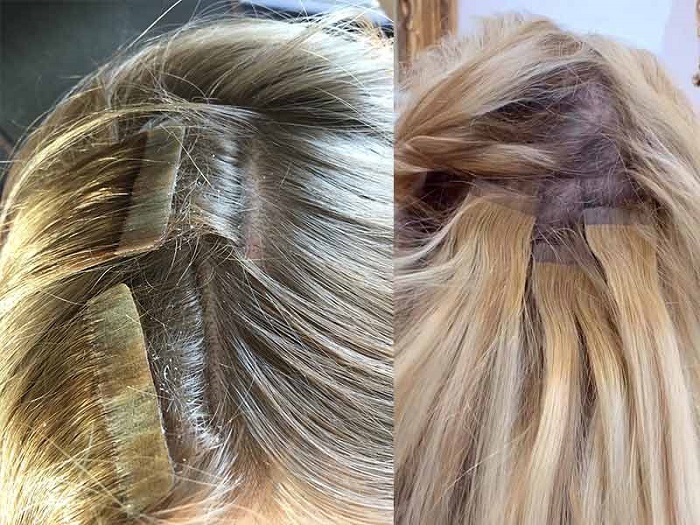Blog, Product Blog
What are the best hair extensions for thin hair?
Many people with thin hair ponder whether they should go for hair extensions since hair extensions can damage their hair. Yet, in fact, if you go with the right type of hair extensions, it will push your confidence without causing any harm to your hair. So, what are the best hair extensions for thin hair? Scroll down to find the answer.
How to choose hair extensions for thin hair?
Hair extensions should always complement your hair type. Therefore, when selecting hair extensions, the first factor you should take into consideration is your hair type. Each kind of hair extension has advantages and disadvantages. Some people might like clip-in extensions since they can take them out each night while others would prefer hand-tied extensions due to their natural look. Below are some tips on choosing the right hair extensions for your hair type:
- Choose a lightweight one: If you have thin hair, you should think about how much weight and tension the hair extensions can cause to your hair. Since the thin strands cannot hold the heavy hair, the hair extensions will slide out of your head quickly.
For people with thin hair, the lighter the hair extensions are, the less likely they will slip off and cause tension in your head. For instance, strand-by-strand extensions could seem preferable because they’re lighter on your hair, but the way they’re applied might put too much strain on your hair.
- Choose hair extensions that are least likely to harm your hair: Damage often occurs during the installation and removal process. Accordingly, to prevent hair extensions damage to your hair, it’s best to look for those that require gentle application and removal.
- Consider how you can make them mix in with your hair: If your hair is thin, it’s important to consider ways to hide extensions under your natural hair. Human hair extensions can blend in natural hair much better than synthetic ones. Normally, your hairstylist can offer advice on how to match your hair type and hair extensions.

Best hair extensions for thin hair
Hand-tied wefts
Hand-tied wefts are hair extensions in which the hair strands are hand-sewn together. It looks more natural against the scalp since this method uses less hair, which results in a thinner lining.
Hand-tied wefts are the best option for giving natural volume to thin, fine hair thanks to their light and delicate design. The wefts lay flat on your hair without adding bulk or weight. Another great thing about hand-tied wefts is that with the right maintenance and care, they can last between four and twelve months.

Halo hair extensions
For thin hair, halo hair extensions are one of the simplest to apply. The installation of halo hair extensions is quick and easy, so you don’t need a hairstylist to do it. What you need to do is just place the hair extensions on like a headband. With your natural hair, you can hide the wire on top of your head. Your thin hair will look long and full in a matter of minutes without causing any harm.

Tape in hair extensions
Tape-ins are one of the most popular hair extensions. They are another choice for people with thin hair since they are lightweight and can be hidden within your hair. However, you should take caution when using tape-ins. It’s not great for ladies who already have thinner hair because the tape’s adhesive can harm your natural hair if it’s not attached or removed properly.
Tape-in extensions can make your thin hair appear thicker and more voluminous. Especially, they can last up to eight weeks on each installation and you may reuse them three to four times overall.

Hair extensions to avoid for thin hair
Clip-in hair extensions
Clip-in hair extensions are convenient and simple to apply. They are an excellent choice for people who want to wear them for special occasions or events during the day. However, clip-ins are not an option for people with fine, thin hair. This is due to the weight of the clips, which, if the hair is too thin, could cause them to slide off. Additionally, thin hair can’t seem to hide the clips, making it obvious that you are wearing extensions.
Fusion hair extensions
Fusion hair extensions, or pre-bonded hair extensions, employ adhesive to attach hair extensions to individual natural hair strands. Due to the exposure of the hair to adhesives and heat during the application, this hair extension method is not a good choice for thin hair. Moreover, the adhesive does not hold well with the thin hair strands.
Sew-in weave
With this hair extensions method, you need to braid your hair close to the scalp and sew the wefts into the braids. Although this is a common type of hair extension, this choice might not be ideal for those with thin hair because braids require a thick base of the hair. Furthermore, sew-ins can cause stress and breakage to your natural hair.
How to blend your thin hair with hair extensions?
To blend your hair extensions into your thin hair, the first thing you need to do is to choose hair extensions that have the same or similar color to your natural hair. After that, your stylist will strategically install the hair extensions so that they match the texture of your hair. Once your stylist finishes the installation process, they can trim and color the ends of your hair to ensure a natural look.
Hair extensions will only damage your thin hair if they are heavy and require heat and adhesive to apply. Hence, as long as you choose the right type of hair extensions, you can boost your look without damaging your hair. Stick to our recommended hair extensions above and you can be safe with your hair items!

